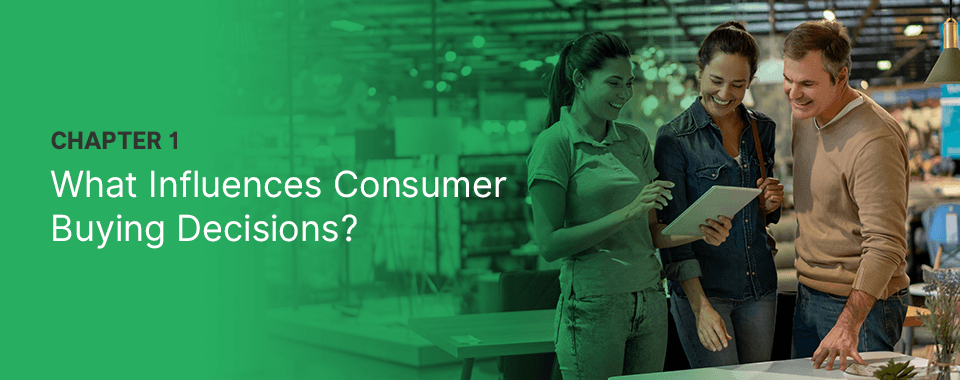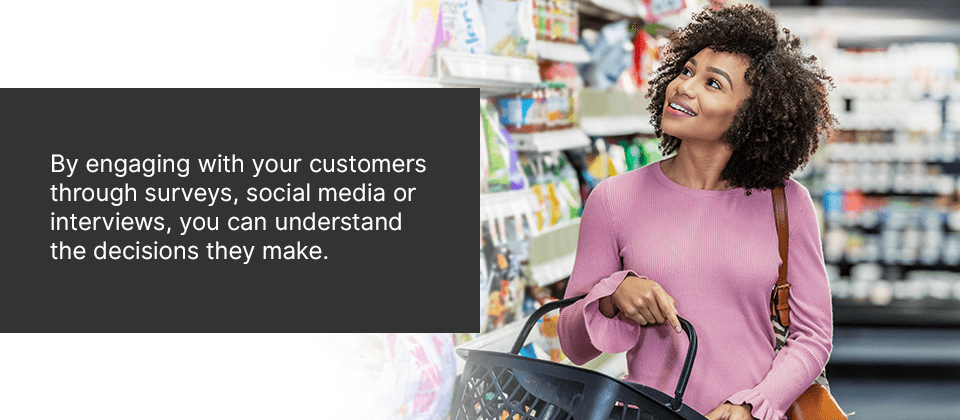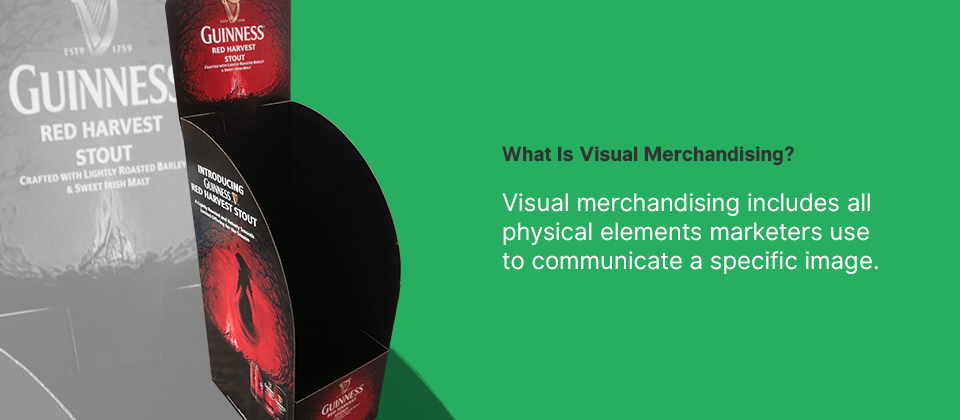Chapter 1: What Influences Consumer Buying Decisions?
Various factors influence a consumer’s decision to purchase something, from their lifestyle to how a product looks. For example, a customer who cares about climate change is more likely to purchase a candy bar that’s Rainforest Alliance certified than a snack that does not have any type of green product certification.
Marketers study consumer behavior so they can sell products that customers want to buy. They must pull knowledge from various fields, including psychology, sociology and economics, to understand their customers. As a supplier, you can learn the factors that prompt a person to try a new brand or buy an item on impulse and use this information to design an effective beverage display.
This chapter explores consumer behavior and the power of visual merchandising to help you determine what makes your customers pick a product off the shelf. If you need help designing an eye-catching display, please contact us at Creative Displays Now.
11 Factors That Influence Consumer Purchasing Decisions
Shopping seems like a simple process: Consumers recognize a need and then go to a store to buy items that fill that need. However, deciding to buy something is a lot more complex than simply filling a need. Customers may not be aware of the factors that urge them to make a purchase, such as a store’s atmosphere or their cultural background.
Marketers, on the other hand, must recognize the subconscious drivers that encourage people to shop. Using these insights, marketers can design impactful displays and show how a product meets customers’ specific needs and adds value to their lives.
So, what are the ingredients that compel someone to toss a product in their cart? To help you understand your customers better, here are 11 factors that influence consumer buying decisions:
1. Layout
A store’s layout is carefully designed to influence consumers and facilitate buying. For example, retailers place items near checkout lines to receive greater attention and encourage impulse buys. Stores also put displays in high-traffic areas to ensure they grab customers’ attention as they move through the store. According to Hawkins Stern’s impulse buying theory, external stimuli, such as strategically placed displays, impact consumers’ impulse control and are not related to traditional decision-making.
2. Atmosphere
Merchandisers use music, lighting and even scent to create an appealing atmosphere and encourage customers to linger in the store. When customers spend more time in a store, they find additional opportunities to spend money.
A store’s atmosphere can also affect what customers buy. For example, a study found that shoppers purchased more French wine when French music played in a supermarket and bought more German wine when the store played German music.
3. Time
The time of day impacts a person’s shopping decisions. For example, if someone runs into a store before eating dinner, they are more likely to buy snacks on impulse to relieve their hunger pangs. Some retailers are in tune with how buying habits change throughout the day and restock items accordingly.
The day of the week also influences how much people spend in the store. For instance, if someone gets paid on a Friday, they can go shopping and spend more money than if it wasn’t payday. Retailers know that customers prefer to shop after they get paid and on weekends — when people typically stock up for the workweek ahead. Knowing this, stores prepare for weekend shoppers by releasing deals and new products on Tuesdays and Wednesdays.
Finally, whether a consumer is in a hurry affects what they buy. According to Stern’s impulse buying theory, customers might plan to buy a product on impulse, even though they aren’t sure about the specifics. If they are short of time, they might pick up the item that appeals to them most without considering other factors. Companies aim to make it easy for customers to shop and make quick decisions.
4. Mood
If you’ve ever felt like going on a shopping spree or doing anything but go into a store, you know how mood can impact buying decisions. To some people, a lousy mood spoils their desire to shop. However, even if a consumer feels glum, particularly due to financial troubles, they may spend more on sale items. During the Great Recession, Walmart and Costco saw a boost in sales of their house brands, while upscale retailers saw purchases drop.
Others feel an elevated mood after they hit the stores. According to an article in the Journal of the Academy of Marketing Science, people may engage in impulse buying to lift a negative mood and enjoy “retail therapy.” Fortunately, if you’re a product manufacturer, a compelling display can help you reach consumers regardless of their mood.
5. Personality
Personality includes a person’s unique traits and describes why they behave a certain way. Marketers know that a person’s personality can impact impulse buying. For example, people who score high on impulsivity traits are, perhaps unsurprisingly, more likely to purchase items on impulse. People with more self-control, on the other hand, are less likely to impulse buy. Nevertheless, customers spend $5,400 a year on average purchasing items such as food, clothing, shoes and household goods on impulse.
6. Self-Concept
Self-concept is how a person views him or herself. People have an ideal self or how they desire to see themselves. Some customers may wish to view themselves as prettier or more eco-conscious, for instance. Researchers believe consumers purchase products that make them feel closer to their ideal self. Many cosmetic companies advertise their products to appeal to a shopper’s perfect self.
7. Demographics
Factors such as age, gender, income, education and stage of life all impact a consumer’s decision to buy something. To illustrate, younger shoppers are more likely to impulse buy while older shoppers can better regulate their emotions and resist purchasing something on a whim.
Also, women and men tend to buy different products. According to the University of Minnesota, women influence about two-thirds of household product purchases, while men are more likely to buy alcoholic beverages. This is why you’ll find beer commercials on sports channels and household products designed to appeal to women.
Overall, knowing your target market will help you create a display that connects with the right customers.
8. Lifestyle
Consumers want products that reflect their values, opinions and interests. For instance, consumers who value naturalness, nutrition and safety will be drawn to products that communicate these values.
Companies might survey customers and find out what they like to do in their free time and what matters most to them in life. Businesses can also use social media to investigate their customers’ likes and dislikes. The more a company can learn about a target audience’s lifestyle, the easier it’ll be to design products and displays that connect with shoppers.
9. Psychology
Psychological factors such as motivation, perception, learning and attitude all play roles in consumer purchasing decisions. Consider research from San Diego State University, which shows how consumers were less likely to purchase familiar items if the products were on a messy shelf because they perceived them as contaminated. However, when customers viewed unfamiliar brands on a messy, picked-through shelf, they perceived the items as popular and were more likely to buy them.
To learn about the motivation to shop, you might refer to Abraham Maslow’s motivation-need theory. According to Maslow’s theory, people fulfill their needs based on a priority system. The most critical needs include survival and safety. These needs are followed by the desire for love, esteem and self-actualization. Marketers keep Maslow’s theory in mind and advertise how products satisfy these needs. For example, a car manufacturer might highlight a new vehicle’s safety features to appeal to consumers’ need for security.
10. Culture
Culture describes shared beliefs, customs, attitudes and behaviors in a society. Culture dictates how a person should live, including what they should buy. Marketers might consider Thorstein Veblen’s social-psychological model, which suggests humans conform to their culture’s standards because they are social creatures. According to Veblen, people’s desires and needs are created and shaped by their cultural group.
As an example, think of how vegetarian and gluten-free products are becoming easier to find in supermarkets. Since these items are increasingly becoming the cultural “norm,” consumers are more likely to purchase these products even if they regularly eat meat and gluten. Consider this statistic: Ninety-five percent of people who order vegan burgers in a restaurant are meat-eaters.
11. Family
Consumers’ family members greatly influence what they buy. For example, people often purchase brands their parents used to buy. Children also greatly influence what their parents purchase in the store. This is why marketers create packaging that appeals to children and prompts them to ask their parents to buy something.
Lastly, consumers trust what their family members say about a brand more than what websites, celebrities or salespeople say.
Applying the Above Factors
Consider all of the above factors when you determine your target consumer, and design a display that speaks to them. By engaging with your customers through surveys, social media or interviews, you can understand the decisions they make.
The Impact of Value Drivers
Another way to approach consumer buying behavior is to explore value drivers. A value driver is anything that makes a product more appealing, and it impacts consumer purchasing decisions.
According to a 2016 Deloitte report, which explores value drivers in the food and beverage industry, traditional drivers include price, taste and convenience. Consumers still consider these factors when they make food or beverage purchases, but other drivers are becoming vital in the buying process. These include:
- Health and wellness: Health and wellness is the most crucial evolving driver for consumers. Today’s consumers look for products that have all-natural ingredients, nutrition and organic roots. For example, 41% of consumers check the front of a product’s package to see if it includes whole grains and low sodium.
- Safety: Safety includes accurate product labels and the absence of allergens. The majority of consumers think it’s important to consider if products are free of harmful elements.
- Social impact: Consumers care about the impact companies make on the world, and they look for products that support sustainability, animal welfare and fair treatment of workers. Social impact is especially important to millennials, wealthier shoppers and parents.
- Experience: Customers expect positive experiences when they purchase a product beyond their trip to the store. They want companies to engage with them in a personalized way, and they want to trust the brands they buy.
- Transparency: Products should have easy-to-read labels and certification by credible third parties. Customers want easy access to brand information in stores and online.
A 2020 Deloitte report supports previous findings by stating that consumers demand simpler labels. A simple label helps consumers quickly understand nutritional information.
It’s important to note that these drivers are not limited to certain income groups, regions or ages. Food and beverage manufacturers need to keep these drivers in mind when targeting any consumer.
What Is Visual Merchandising?
Your display research should involve consumer behavior so you can apply that information to visual merchandising. Visual merchandising includes all physical elements marketers use to communicate a specific image. In a retail setting, visual merchandising includes layout, displays, product placements, packaging, signage, color schemes and other design elements. Visual merchandising is a way for retailers to create a unique look that sets them apart from competitors.
The primary goal of visual merchandising is to encourage a target market to purchase products. If customers like the way a store looks, including the way products appear in a store, they are bound to spend more time and money during their visit. Beverage displays are a significant component of a store’s visual merchandising strategy.
How Does Visual Merchandising Increase Sales?
Simply put, visual merchandising makes products more attractive to customers. It can be a highly effective way to boost sales and customer satisfaction. Regarding beverage sales, here’s how visual merchandising helps:
- Alters perception: Visual merchandising has the power to change the way a consumer perceives a beverage product. Imagine placing a new and unusual beverage alongside well-known brands. Customers might not even notice the drink, and if they do, they may perceive it as something unfamiliar and not worth trying. Now, imagine placing the beverage in a colorful display that shows customers the unique, healthy ingredients in the drink. As a result, shoppers will see this product as something that could add value to their lives and not just another item on the shelf.
- Promotes impulse buys: Part of visual merchandising is placing products in customers’ paths. When customers need to walk past enticing displays on their way to the checkout line, for instance, they’re more likely to pause at the display, pick up a product that appeals to them and purchase it on impulse.
- Enhances the price image: Price image is how customers view a retailer’s costs compared to competitors. Visual merchandising allows retailers to create an image of discounted prices and savings, tempting customers to return. Retail displays, such as ones that advertise sales, help make a positive price image for a store.
- Simplifies buying: Visual merchandising includes strategically placing products to make it easier for customers to make purchasing decisions. For instance, it’s not uncommon to find complementary items grouped together, such as chips and soda. In such an example, customers don’t have to think twice about choosing the right snack to pair with their beverage. Also, customers should not feel confused when they shop. All the information they need about a product should be right in front of them, including prices and nutritional details.
While you certainly have a lot to think about when designing a beverage display, the key is to focus on your target audience. At Creative Displays Now, we’ll take your audience into account, and we’ll also meet your retailer’s specifications when we custom-make your unique display.



